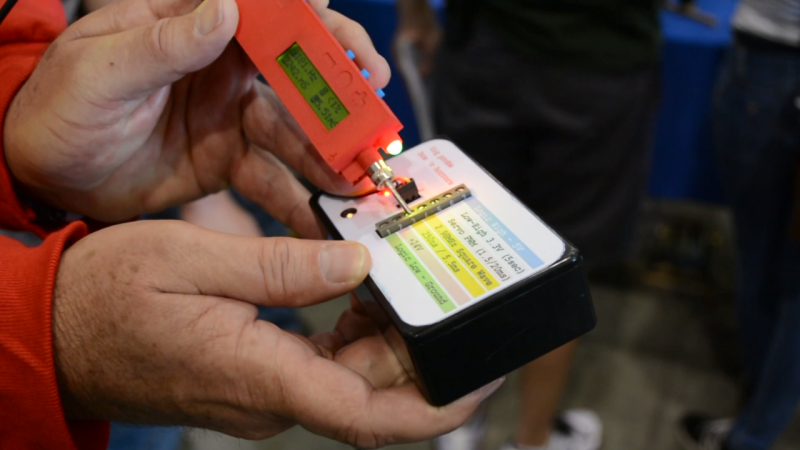[youtube=https://www.youtube.com/watch?v=XZz1W-LurlU&w=580]
We had [Mark] on our “dance card” for people to find at Maker Faire. But before we could track him down he bumped into us holding the TIQ Probe in one hand and a testing box in the other. TIQ is conceived in the form factor of a traditional logic probe but thanks to the Cypress PSoC 5LP inside it’s much, much smarter than the decades-old bench tools. Sure, it can tell you if that uC pin is a 1 or a 0, but it can also detect what type of signal it’s probing and has built-in protection for over-voltage.
The point of the tool is to bridge the gap between things which would be measured with a DMM and those measured with a proper Oscilloscope. We think he did a pretty good job of including the things that someone just starting out without expensive bench equipment might want. For instance, you can set it to trigger on common data protocols like i2c, and use the probe itself as a rudimentary pulse generator.
The bulk of the details on the probe can be found on its Kickstarter page (which has just a few days left). You may also be interested in his company page. We’re curious about the insides of the test rig he was hauling around. [Mark] is a regular reader so hopefully he’ll leave a comment below with the details of that black box.

















I love PSoC based designs – but a project like this would be far, far more useful if I could hack the firmware to make it do what I want.
Reminds me of the old superprobe except it is some assembly required. I made one years ago. It is based on a pic 16f and has most the same features. The plans and code are available here:
http://mondo-technology.com/super.html
Yep, that’s what I was thinking. There’s at least two versions of that.
Microchip themselves did one that was very nice (I never built one) and did a lot of stuff, called “The Engineers Assistant” or something like that.
Then there’s another simpler one, based on the 16F PIC chip, that also did a lot of stuff, but was a heck of a lot simpler as far as the hardware went.
Both were pretty nice looking, I’ve got the plans for them and plan on making something similar to both, but more expanded.
SuperProbe is a great DIY tool (I have one!), however tiq is distinctly different – in 3 key ways – 1) tiq measurement functions are implemented in hardware inside the pSoC 5LP – so it’s able to measure something like 20x faster signals, 2) tiq switches functions automatically based on what you measure, SuperProbe has a lot of functions, but you have to switch them manually and 3) tiq has a 32 character display, an RGB LED and an audio beeper – SuperProbe has a 4 digit 7 segment LED display.
Just a thought…
Wouldn’t leveraging the USB for (optional) data communication to a host, instead of simply a power source, push this off the awesome scale?
I’m at that crossroads where I decided I need more than a DMM but can’t figure out which tool I need.
It was great to meet Mike and the HaD team at Maker Faire! The test rig Mike refers to was hacked together for the Faire (“box o’ horrors”) to show how some common signal types can be instantly viewed on tiq, without range switching or adjustments – like a narrow pulse (250ns) with a low rep rate (5.5ms) – tough to see on a ‘scope. The box has a $25 Cypress pSoC 4 “Pioneer” eval board inside, with a DC-DC converter making 24V from the demo board 5V. I packed some PWM, counter and DAC goodness into the pSoC 4 using the *free* Cypress pSoC Creator software, and with a box and a terminal strip the portable box o’ horrors was done! Powered both the tiq and the box from a 2 port USB battery booster – that ran the whole rig for 2 long days at the Faire!
Speaking of mcu based logic probes. I build this msp430 based EZProbe a couple of years ago. It’s smaller and simpler than both SuperProbe and TIQ Probe. And apart from logic probe, it is capable of counting frequency ranges and also work as a simple signal generator w/ pwm.
http://youtu.be/-ZYLLT5RbMY
http://www.simpleavr.com/msp430-projects/ezprobe
A key difference with tiq is that the pSoC 5LP allows the measurement functions to be implemented in 66MHz HARDWARE vs. the firmware approach in 16MHz MCU-based designs. So tiq measures frequency to 20MHz, and pulse widths <100nS. Can't do that in software ;-). Note tiq has a pulse generator of equivalent performance – programmable pulse high and low times from 100ms (so it does PWM, too).
The guy says it for me at 2:03.
tiq did not meet goal on Kickstarter, however development is continuing and Innavatus will be offering this product soon! Please visit http://www.innavatus.com!
tiq: still nothing.
Re: Microchip’s (now Atmel) variant, PIC Engineer’s Assistant: http://ww1.microchip.com/downloads/en/AppNotes/00689a.pdf
Ben Ryves Superprobe: http://benryves.com/journal/3632205